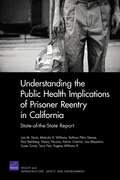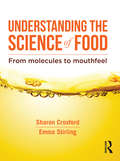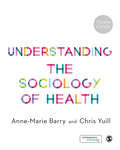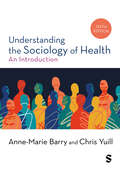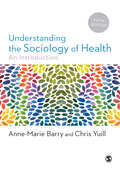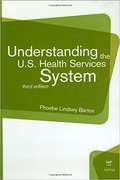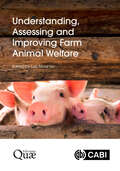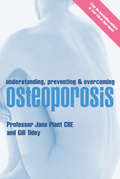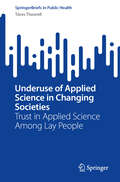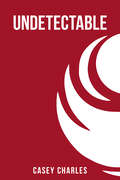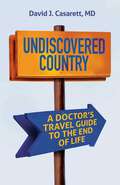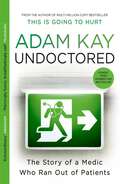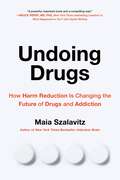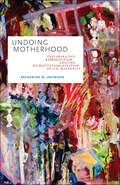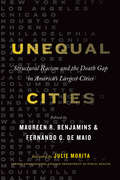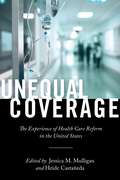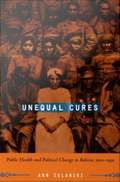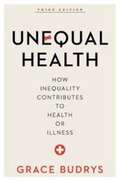- Table View
- List View
Understanding the Public Health Implications of Prisoner Reentry in California
by Lois M. Davis Kathryn Pitkin Derose Paul Steinberg Malcolm V. Williams Nancy NicosiaExamines the health care needs of newly released California prisoners; the communities most affected by reentry and the health care safety net of those communities; the critical roles that health care providers, other social services, and family members play in successful reentry; and the effects of reentry on the children and families of incarcerated individuals. Recommends how to improve access for this population in the current fiscal environment.
Understanding the Science and Practice of Public Health
by Richard CrosbyA civically minded approach to public health, perfect for students on any career path Understanding the Science and Practice of Public Health is an exciting new textbook designed specifically for introductory public health courses at the college level. In a world rapidly being challenged by climate change, starvation, water shortages, and epidemics—and in a nation plagued by obesity, diabetes, early onset cardiovascular disease, cancer, and gun violence—this book provides students with crucial information that they’ll need to understand what’s going on around them. Thematically, this book focuses on the viewpoint that “We the People” have the ultimate responsibility to collectively assure the conditions that allow people to successfully seek health and well-being. Public health is a public responsibility (a maxim often repeated in the book), and college and university students must be fully informed to optimally meet this vital civic obligation. Written to be accessible to students in any major, this unique text prepares students to participate in the daily actions needed (including advocacy and support of health-related regulations and policy) to become participants in public health practice, rather than passive recipients. Readers will: Get an accessible introduction to the most pressing public health issues of today Learn how public health is promoted in society using real-world examples Become knowledgeable about public health so you can make informed decisions at the voting booth and in daily life Discover the practice of public health as it applies to pandemics, substance abuse, climate change, gun violence, and moreThe science and practice of public health depends on a well-informed and highly engaged population of civic-minded adults. This book will enable students’ enthusiastic participation in savings lives and promoting health—no matter what career path they decide to pursue.
Understanding the Science of Food: From molecules to mouthfeel
by Emma Stirling Sharon CroxfordBeing able to understand the principles of food science is vital for the study of food, nutrition and the culinary arts. In this innovative text, the authors explain in straightforward and accessible terms the theory and application of chemistry to these fields.The key processes in food preparation and the chemistry behind them are described in detail, including denaturation and coagulation of proteins, gelatinisation, gelation and retrogradation of starches, thickening and gelling, browning reactions, emulsification, foams and spherification, chemical, mechanical and biological leaveners and fermentation and preservation. The text also describes the science of key cooking techniques, the science of the senses and the experience of food, food regulations and the future of healthy food. The origins of food are explored through a focus on the primary production of key staples and their journey to the table. Tips and advice from leading chefs as well as insights into emerging food science and cutting-edge nutrition research from around the world are included throughout, and reveal both the practical application of food chemistry and the importance of this field. Featuring explanatory diagrams and illustrations throughout, Understanding the Science of Food is destined to become an essential reference for both students and professionals.'An innovative and informative text that will address the need for a food science text suitable for nutrition and dietetics students in Australia.' - Katherine Hanna, Faculty of Health, Queensland University of Technology.'A unique and timely text that will be welcomed by students, instructors, and scientists in multiple disciplines. I am thrilled to see such a modern take on the subject, blending the fundamentals of food science and chemistry with the insights and experience of practitioners from the culinary arts.' - Patrick Spicer, lecturer and researcher in food science
Understanding the Sociology of Health: An Introduction
by Chris Yuill Anne-Marie BarryUnderstanding the Sociology of Health continues to offer an easy to read introduction to sociological theories essential to understanding the current health climate. Up-to-date with key policy and research, and including case studies and exercises to critically engage the reader, this book shows how sociology can answer complex questions about health and illness, such as why health inequalities exist. To better help with your studies this book contains: · a global perspective with international examples; · a new chapter on health technologies; · online access to videos of the author discussing key topics as well as recommended further readings; · a glossary, chapter summaries and reflective questions to help you engage with the subject. Though aimed primarily at students on health and social care courses and professions allied to medicine, this textbook provides valuable insights for anyone interested in the social aspects of health.
Understanding the Sociology of Health: An Introduction
by Chris Yuill Anne-Marie BarryUnderstanding the Sociology of Health continues to offer an easy to read introduction to sociological theories essential to understanding the current health climate. Up-to-date with key policy and research, and including case studies and exercises to critically engage the reader, this book shows how sociology can answer complex questions about health and illness, such as why health inequalities exist. To better help with your studies this book contains: · a global perspective with international examples; · a new chapter on health technologies; · online access to videos of the author discussing key topics as well as recommended further readings; · a glossary, chapter summaries and reflective questions to help you engage with the subject. Though aimed primarily at students on health and social care courses and professions allied to medicine, this textbook provides valuable insights for anyone interested in the social aspects of health.
Understanding the Sociology of Health: An Introduction
by Chris Yuill Anne-Marie BarryWhy do health inequalities exist? How do gender, sexuality, race, ethnicity or class affect health? How do climate change and technology impact health and illness? Written in a clear, student-friendly style, this is an exploration of the key sociological debates, themes and theories as they relate to health. Taking a global perspective, it is packed with comparative examples, case studies and activities, showing how sociology can answer complex questions about health and illness and make you a better practitioner. In this book you will: · Build your foundational knowledge with clear discussions of the research and perspectives within the sociology of health, along with a historical overview of the subject. · Read chapters based on a diverse range of key themes from gender and sexuality to health inequalities, race, class, mental health and ageing. · Apply what you’ve learnt across different cutting-edge contexts and real-life situations, including pandemics, policy, sport, and technology. This textbook provides valuable insights for anyone studying health and social care, nursing or who is interested in the social aspects of health.
Understanding the Sociology of Health: An Introduction
by Chris Yuill Anne-Marie BarryWhy do health inequalities exist? How do gender, sexuality, race, ethnicity or class affect health? How do climate change and technology impact health and illness? Written in a clear, student-friendly style, this is an exploration of the key sociological debates, themes and theories as they relate to health. Taking a global perspective, it is packed with comparative examples, case studies and activities, showing how sociology can answer complex questions about health and illness and make you a better practitioner. In this book you will: · Build your foundational knowledge with clear discussions of the research and perspectives within the sociology of health, along with a historical overview of the subject. · Read chapters based on a diverse range of key themes from gender and sexuality to health inequalities, race, class, mental health and ageing. · Apply what you’ve learnt across different cutting-edge contexts and real-life situations, including pandemics, policy, sport, and technology. This textbook provides valuable insights for anyone studying health and social care, nursing or who is interested in the social aspects of health.
Understanding the Sociology of Health: An Introduction
by Chris Yuill Anne-Marie BarryWhy do health inequalities exist? How do gender, sexuality, race, ethnicity or class affect health? What is the healthcare impact of technology? How does climate change relate to health and illness and what does sociology have to teach us about pandemics? This textbook exists to answer these complex questions providing a complete overview of all the key sociological debates, themes, theories and research. Key features: Takes a global perspective providing comparative examples throughout Grapples with the most pressing healthcare debates including climate change and environment, pandemics and society, racism, health inequality and gender identity Breaks the complexities down using extremely clear language throughout Lecturers and instructors can also access a range of additional teaching resources available from the SAGE website. Though aimed primarily at students on health and social care courses and professions allied to medicine, this textbook provides valuable insights for anyone interested in the social aspects of health.
Understanding the Sociology of Health: An Introduction
by Chris Yuill Anne-Marie BarryWhy do health inequalities exist? How do gender, sexuality, race, ethnicity or class affect health? What is the healthcare impact of technology? How does climate change relate to health and illness and what does sociology have to teach us about pandemics? This textbook exists to answer these complex questions providing a complete overview of all the key sociological debates, themes, theories and research. Key features: Takes a global perspective providing comparative examples throughout Grapples with the most pressing healthcare debates including climate change and environment, pandemics and society, racism, health inequality and gender identity Breaks the complexities down using extremely clear language throughout Lecturers and instructors can also access a range of additional teaching resources available from the SAGE website. Though aimed primarily at students on health and social care courses and professions allied to medicine, this textbook provides valuable insights for anyone interested in the social aspects of health.
Understanding the U.S. Health Services System (3rd Edition)
by Phoebe Lindsey BartonThis comprehensive book is the definitive text on how the U.S. health services system is organized and financed. The text addresses each aspect of system organization, management, financing, resource production, and delivery components.
Understanding, Assessing and Improving Farm Animal Welfare
by Luc MounierImproving welfare in farmed animals is good for productivity, consumer demand and, of course, the animals themselves. Covering the current scientific knowledge on the sensitivity and consciousness of animals, this translation of the Le Bien-être des animaux d'élevage series reviews how to understand, assess and then improve farm animal welfare. Beginning with the philosophical and legal history of the consideration of their well-being, it synthesizes this information to build a common reference so that we all share the same notion of what animal welfare actually is. It then evaluates the welfare assessment process, which must be as reliable and objective as possible and require the use of appropriate indicators. Fully outlined in reference documents, these are summarized at the level of specific farming situations for easy reference. Concluding with the different ways of improving animal welfare, the book takes a holistic approach, considering the animals' physical and social environment, the integrated management of their health, the relationship between human and animal, the management of animal suffering, and treatment of animals during transportation and slaughter. Suitable for students and researchers of animal agriculture, animal science and veterinary medicine, this book provides an approachable and comprehensive coverage of this important topic.
Understanding, Preventing and Overcoming Osteoporosis
by Gillian Tidey Jane Plant CBEWith the help of this book you can:* Learn how to prevent osteoporosis* Improve your chances of increasing your bone strength and health if you suffer from osteoporosis* Discover how to get the best out of othodox medicine* Educate yourself about the fundamental importance of diet and lifestyle, with seven Food Factors and eight Lifestyle Factors, aimed at improving your bone health, appearance and outlook.* Follow a new dietary regime based on delicious recipes* Above all, discover a diet and lifestyle that will empower you to prevent and combat the disease.
Underuse of Applied Science in Changing Societies: Trust in Applied Science Among Lay People (SpringerBriefs in Public Health)
by Töres TheorellThis book discusses the fact that applied science is underused in modern societies. The problem is discussed both from external points of view (trust among lay people, attitudes among politicians) and from the inside (recruitment of researchers, research education, violations of scientific rules, financial processes). The book concludes with suggested solutions. Democracy is threatened in many countries in the free world. The same is true of applied science. It could be argued that in a world situation in which increasing numbers of people distrust politicians, applied science would be the sector people should turn to for advice. However, this seems to occur to a decreasing extent. Increasing numbers of results are produced by applied scientists and these results often diverge. In that situation, laymen tend to select the research results that confirm their own ideas. In such a situation one could ask whether it is meaningful to have applied science and to allocate money to it. There are threats to applied science coming from external sources, with politicians and higher administration increasingly disregarding applied science, but also from the inside. Researchers reporting results dishonestly or in exaggerated ways and researchers who avoid results that do not confirm their own hypotheses are eroding the trust in applied science. This book, which uses Sweden, a small European country with old and strong democratic and scientific traditions, as an empirical example, puts all the external and internal problems surrounding applied science in one context. Among the topics covered: Introduction, why do people not listen? Production and producers Research students How does applied science operate? Communication with society Examples of situations in which applied science should have been used more Solutions Conclusions Underuse of Applied Science in Changing Societies: Trust in Applied Science Among Lay People is an essential resource for researchers, research students, and research teachers in psychosomatic medicine, psychiatry, behavioral medicine, social medicine, psychology, sociology, social work, nursing, and public health. Societal actors also would find the book a useful resource for their work.
Undetectable
by Casey CharlesUndetectable is a story of love, loss, and viral loads, a memoir of long-term survival with HIV. From New York graduate student in 1989, who contracts the virus from the love of his life to Montana writer in 2018 visiting the slums of Nairobi, the author finds his own drama intertwined with the astonishing stories of his HIV+ peers, narratives that intersect the path of his travails and act as foils to the foibles of a gay man who comes out, falls in love, and faces a death sentence at the beginning of his career. In his fight for drugs, friends, and support, Charles learns the power of linking self to other as he confronts stigma, heartbreak, and fear with a visceral resilience. By discovering the power of community, Undetectable explores a generation of long-term HIV survivors who have lived to tell the story of an AIDS pandemic now in its fifth decade without cure or vaccine.
Undiscovered Country: A Doctor's Travel Guide to the End of Life
by David CasarettTransform the fear of death into a sense of wonder.In Undiscovered Country, embark on a riveting exploration of the final frontier and unraveling the mysteries of our last hours. This insightful narrative delves into the complexities of death, dissecting the gradual disintegration of order and control, the skewed metabolic balance, and the profound transformations within our bodies. Join physician and researcher David Casarett as he guides readers across this captivating journey that not only explores the extreme moments of life but also encourages a conscious and less daunting approach to life&’s final passage. As the science of dying unveils the body&’s tactical attempts at self-preservation and the remarkable manifestations of order even in chaos, Casarett explores longstanding mysteries surrounding the precise moment life ceases. Discover how the study of life's culmination provides profound insights into normal functioning and empowers individuals to shape their own pathways toward death, maximizing comfort, alertness, and dignity. Undiscovered Country bridges scientific inquiry and existential contemplation, empowering readers to confront and comprehend the inevitable and offering a less fearful approach to the end of life.
Undo the Past
by Gill SandersonLaura McLeod enjoyed her work on the paediatric ward, but she was less involved with the social side of the hospital. The arrival of the new Senior Registrar, John Hawke, wouldn't, she thought, change that. But John had other ideas. He could see she was hiding something from the world, something she needed to face before she could go forward to really enjoy her life. And if he could persuade her to make him part of that life, so much the better ...
Undo the Past: A Sweet and Touching Medical Romance (Medical Romances #22)
by Gill SandersonAnother heartwarming medical romance from best-selling author Gill Sanderson! Perfect for fans of Mia Faye, Laura Scott, Helen Scott Taylor, Grey's Anatomy and ER.Readers ADORE Gill's delightful medical romances! 'Excellent story and very difficult to put down' 5* reader review'A lovely, gentle romantic tale that leaves you feeling good at the end' 5* reader review'Yet another fascinating tale! What a truly wonderful story teller!' 5*reader reviewLaura McLeod enjoyed her work on the paediatric ward, but she was less involved with the social side of the hospital. She assumed that the arrival of the new Senior Registrar, John Hawke, wouldn't change that. But John had other ideas. He could see she was hiding something from the world, something she needed to face before she could go forward and really enjoy her life. If he could persuade her to make him part of that life, so much the better...Don't miss Gill Sanderson's dreamy medical romances, including the A Lakeland Practice and the Good, Bad and Ugly series.
Undoctored: Pre-order the brand-new book from the author of 'This Is Going To Hurt'
by Adam KayPre-order UNDOCTORED: The Story of a Medic Who Ran Out of PatientsThis is Going to Hurt was the publishing phenomenon of the century, read by many millions, loved by at least fifty of them, and adapted into a major TV series. But it was only part of the story. By turns hilarious, heartbreaking and humbling, Undoctored is about what happens when a doctor hangs up his scrubs, but medicine refuses to let go of him.It's about an extraordinary medical school education. It's about opening old wounds and examining the present-day scars.It's about hospital admissions and personal ones. It's about blowing up your life and stitching it back together.It's about being a doctor and being a patient.It's about 300 pages long. Undoctored is Adam Kay's funniest and most moving book yet - an astonishing portrait of a life in and out of medicine, from one of Britain's finest storytellers.
Undoctored: The brand new No 1 Sunday Times bestseller from the author of 'This Is Going To Hurt’
by Adam KayPre-order UNDOCTORED: The Story of a Medic Who Ran Out of PatientsThis is Going to Hurt was the publishing phenomenon of the century, read by many millions, loved by at least fifty of them, and adapted into a major TV series. But it was only part of the story. By turns hilarious, heartbreaking and humbling, Undoctored is about what happens when a doctor hangs up his scrubs, but medicine refuses to let go of him.It's about an extraordinary medical school education. It's about opening old wounds and examining the present-day scars.It's about hospital admissions and personal ones. It's about blowing up your life and stitching it back together.It's about being a doctor and being a patient.It's about 300 pages long. Undoctored is Adam Kay's funniest and most moving book yet - an astonishing portrait of a life in and out of medicine, from one of Britain's finest storytellers.
Undoing Drugs: The Untold Story of Harm Reduction and the Future of Addiction
by Maia Szalavitz&“Of the countless writers out there whose focus is addiction, no one can begin to touch the brilliance of Maia Szalavitz.&”—Kristen Johnston, actress, author of the New York Times bestselling memoir Guts, addiction advocate, founder of SLAM NYC Drug overdoses now kill more Americans annually than guns, cars, or breast cancer. But the United States has tried to solve this national crisis with policies that only made matters worse. In the name of &“sending the right message,&” we have maximized the spread of infectious disease, torn families apart, incarcerated millions of mostly Black and Brown people—and utterly failed to either prevent addiction or make effective treatment for it widely available.There is another way—one that is proven to work. However it runs counter to much of the received wisdom about substances and related problems. It is called harm reduction. Created by a group of people who use drugs and by radical public health experts, harm reduction offers a new way of thinking—one that provides startling insights into behavioral and cultural issues that go far beyond drugs.In a spellbinding narrative rooted in an urgent call to action, Undoing Drugs tells the untold tale of a quirky political movement that has unexpectedly shaken the foundations of world drug policy. It illustrates how hard it can be to take on widely accepted conventional thinking—and what is necessary to overcome this resistance. Ultimately, Undoing Drugs offers a path forward—led by characters who spent many years being dismissed as worthless, only to develop a breakthrough philosophy that can dramatically improve world health.
Undoing Motherhood: Collaborative Reproduction and the Deinstitutionalization of U.S. Maternity (Families in Focus)
by Katherine M. JohnsonIn 1978 the world’s first “test-tube baby” was born from in vitro fertilization (IVF), effectively ushering in a paradigm shift for infertility treatment that relied on partially disembodied human reproduction. Beyond IVF, the ability to extract, fertilize, and store reproductive cells outside of the human body has created new opportunities for family building, but also prompted new conflicts about rights to and control over reproductive cells. In collaborative forms of reproduction that build on IVF technologies, such as egg and embryo donation and gestational surrogacy, multiple women may variously contribute to conception, gestation/birth, and the legal and social responsibilities for rearing a child, creating intentionally fragmented maternities. Undoing Motherhood examines the implications of such fragmented maternities in the post-IVF reproductive era for generating maternity uncertainty—an increasing cultural ambiguity about what does and should constitute maternity. Undoing Motherhood explores this uncertainty in the social worlds of reproductive medicine and law.
Unequal Cities: Structural Racism and the Death Gap in America's Largest Cities (Health Equity in America)
by Maureen R. Benjamins and Fernando G. De MaioAcross the United States, Blacks have shorter life expectancies than whites—reflecting structural racism and deep-rooted drivers of population health. But are some cities more equal than others?The elimination of racial and ethnic inequities—differences that are avoidable, unnecessary, and unfair—has been one of the overarching health-related goals of the United States for decades. Yet dramatic differences in health outcomes between Blacks and whites persist, rooted in structural and social determinants of health. Nationally, a Black baby can expect to live four years less than a white baby. But mortality outcomes and inequities vary widely across cities. In Washington, DC, for example, the average life expectancy for Blacks is twelve years less than that of whites. But in other cities, mortality differences between races are less striking or nonexistent. If health equity can be achieved in some cities, why not all? This is arguably the most important health equity issue of our time.In Unequal Cities, Maureen R. Benjamins and Fernando G. De Maio gather a team of experts to explore these racial inequities, as well as the ten-year gap in life expectancy between our healthiest and unhealthiest big cities. Rigorous analyses give readers access to previously unavailable data on life expectancy, mortality from leading causes of death, and related Black-white inequities for the country's 30 biggest cities. The theoretically grounded essays also explore how characteristics of cities, including their levels of income inequality and racial segregation, impact overall health and Black-white inequities.The first book to specifically examine racial health inequities within and across US cities, Unequal Cities offers a social justice framework for addressing the newly identified inequities, as well as specific case studies to help public health advocates, civic leaders, and other stakeholders envision the steps needed to improve their cities' current health outcomes and achieve racial equity. A powerful call to action for health equity advocates and city leaders alike, this book is essential reading.Contributors: David Ansell, Darlene Oliver Hightower, Jana Hirschtick, Sharon Homan, Ayesha Jaco, Emily LaFlamme, Brittney S. Lange-Maia, Kristin Monnard, Nikhil G. Prachand, Pamela T. Roesch, Michael Rozier, Nazia Saiyed, Eve Shapiro, Abigail Silva, Veenu Verma, the West Side United Metrics Working Group, Ruqaiijah Yearby
Unequal Coverage: The Experience of Health Care Reform in the United States (Anthropologies of American Medicine: Culture, Power, and Practice #2)
by Heide CastañedaThe Affordable Care Act’s impact on coverage, access to care, and systematic exclusion in our health care system The Affordable Care Act set off an unprecedented wave of health insurance enrollment as the most sweeping overhaul of the U.S. health insurance system since 1965. In the years since its enactment, some 20 million uninsured Americans gained access to coverage. And yet, the law remained unpopular and politically vulnerable. While the ACA extended social protections to some groups, its implementation was troubled and the act itself created new forms of exclusion. Access to affordable coverage options were highly segmented by state of residence, income, and citizenship status. Unequal Coverage documents the everyday experiences of individuals and families across the U.S. as they attempted to access coverage and care in the five years following the passage of the ACA.It argues that while the Affordable Care Act succeeded in expanding access to care, it did so unevenly, ultimately also generating inequality and stratification. The volume investigates the outcomes of the ACA in communities throughout the country and provides up-close, intimate portraits of individuals and groups trying to access and provide health care for both the newly insured and those who remain uncovered. The contributors use the ACA as a lens to examine more broadly how social welfare policies in a multiracial and multiethnic democracy purport to be inclusive while simultaneously embracing certain kinds of exclusions. Unequal Coverage concludes with an examination of the Affordable Care Act’s uncertain legacy under the new Presidential administration and considers what the future may hold for the American health care system. The book illustrates lessons learned and reveals how the law became a flashpoint for battles over inequality, fairness, and the role of government.More books on the health care debate
Unequal Cures: Public Health and Political Change in Bolivia, 1900-1950
by Ann ZulawskiUnequal Cures illuminates the connections between public health and political change in Bolivia from the beginning of the twentieth century, when the country was a political oligarchy, until the eve of the 1952 national revolution that ushered in universal suffrage, agrarian reform, and the nationalization of Bolivia's tin mines. Ann Zulawski examines both how the period's major ideological and social transformations changed medical thinking and how ideas of public health figured in debates about what kind of country Bolivia should become. Zulawski argues that the emerging populist politics of the 1930s and 1940s helped consolidate Bolivia's medical profession and that improved public health was essential to the creation of a modern state. Yet she finds that at mid-century, women, indigenous Bolivians, and the poor were still considered inferior and consequently received often inadequate medical treatment and lower levels of medical care. Drawing on hospital and cemetery records, censuses, diagnoses, newspaper accounts, and interviews, Zulawski describes the major medical problems that Bolivia faced during the first half of the twentieth century, their social and economic causes, and efforts at their amelioration. Her analysis encompasses the Rockefeller Foundation's campaign against yellow fever, the almost total collapse of Bolivia's health care system during the disastrous Chaco War with Paraguay (1932-35), an assessment of women's health in light of their socioeconomic realities, and a look at Manicomio Pacheco, the national mental hospital.
Unequal Health: How Inequality Contributes to Health or Illness
by Grace BudrysThis book examines the reasons why stark differences in health and well-being persist, even as the health care industry and access to health care grow. The third edition of this powerful book retains the accessible style and focus on inequality from previous editions while featuring significant new material throughout. After an overview of key themes, the book introduces the concept of epidemiology―measuring the number of people who are sick or dying―and offers an overview of health trends over time. <P><P> Author Grace Budrys distills the latest research to consider the relevance of sex, race, income, and education, and relative social status on health. The book discusses disease, habits that contribute to health, the relationship between health care and health status, genetics, socioeconomic inequality, health policy, and more. The third edition features a new chapter on diet, an increased discussion of substance abuse and the attention it receives based on who is engaging in this behavior, new material on income and education variables and inequality, a new discussion of the Affordable Care Act and its impact, and more.
